How To Use Pigment Powder
What would y'all say if I told you all of the horses in the photo below were painted with dry out pigments. No, I don't mean add a medium to plough the dry pigment into oil or acrylic paint. I mean honest to goodness application of dry out pigments. If you desire to learn how to pigment with dry pigments, read on.

Yous probably recollect I'm nuts or the technique would be more trouble than it's worth – or that information technology would wipe out detail. You could probably come up with lots of reasons not to try information technology.
Merely here y'all are reading this article. 😀
While I paint miniatures and various historical figures, I also paint model horses. This is a huge hobby but very few people know about it. It is very like to the miniatures hobby, the but thing unlike is the focus of the discipline – to create the near realistic and authentic to real life horse as possible.
Information technology was in the model horse hobby that I learned this technique and I'd similar to share information technology with you.
How to paint with dry out pigments: Principle
The general thought is very simple. Pigments and pastels are translucent tints – pregnant they are not completely opaque. Y'all build from low-cal to dark and slowly piece of work toward the color you want to attain. The meridian layer's colour is affected past all the layers below it.
Pigments and pastels are translucent tints – meaning they are not completely opaque. Y'all build from calorie-free to dark and slowly piece of work toward the color you desire to accomplish.Starting with a white base, y'all select a calorie-free colour and literally stain your subject with a brush or applicator and slight pressure. When you lot have colored the desired surface, you seal the pigment or pastel with matte sealer. Once the sealer dries, you do it all over again. The color you finish upward with simply depends on where you stop.
Lighter colors, of course, have less layers. Darker colors, all the way to a rich black with blue and brownish undertones can take several. Pigments are pure color, they have no binder then typically accept less layers than pastels. While I utilise both depending on the effect I want, I adopt pigments because of the richer color and amend coverage.
Earlier we begin, allow me to list what you may need, or a least need to know well-nigh.
Supplies
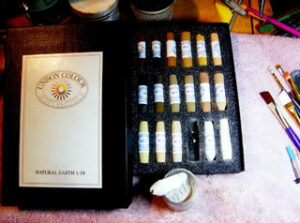
Pastels
I employ both pigments and pastels depending on the desired effect I want to accomplish. For pastels you need to purchase a high quality brand. Pastels are colored pigment and a binder, and so they keep their stick shape. The folder does not have any color. The cheaper pastels have more folder and less pigment, therefore information technology takes more than to achieve a desired color. The higher quality brand names such as Rembrandt, Sennlier, Unison, etc. have more pigments and less binders, then these are the ones you should focus on.
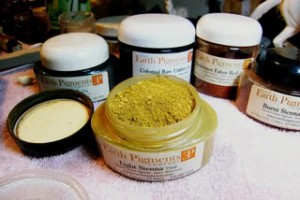
Pigments
I utilize exclusively Earth Pigments. There are several companies that brand pigments, including many for the miniature world for utilise in weathering. In that location are too pigments sold by art supply retailers such as Dick Blick that sell powdered pigments made for the oil painter to make their own oil paints. I would similar to circumspection the reader about these. Please check the labels! The pigments for oil paints tin can comprise ingredients that are toxic – cadmium for Cadmium Bluish for example, is toxic. If you take children and/or pets, exist aware that pigment dust will get EVERYWHERE. In that location is actually no fashion to control it no thing how conscientious you are. So know what is in your supplies.
I utilize Earth Pigments because they have high quality colors, they have a UV rating, their jars are cheap and for what we are doing this small amount will literally last years, and best of all they are NON-TOXIC. Yay! Now, they do take a warning non to breathe in the dust, then it's a practiced idea to have a mask, especially if you're sensitive to things like this. Simply as a whole, World Pigments have a lot of fantastic things going for them.
For those of you in Europe, I have a link (I demand to dig it up) for a visitor that is sorta like Earth Pigments "sister" site, where you tin get the aforementioned thing. I believe they are in France.
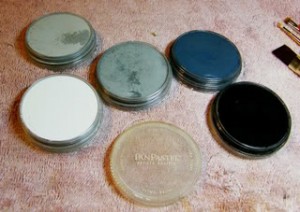
Pan pastels
Like regular pastels, pan pastels are paint mixed with a binder. But these are pressed into a small pan – very much like a make up compact – so the binders are far less than regular stick pastels. They take fantastic color and continue smooth. Once again they are easily available and not that expensive. I similar using the Grays Ready of v from Dick Blick. But they come in a huge variety of colors, tints and shades, so if you lot desire to get others, go right ahead! These little pans actually spiral together to course a stack, and so everything stays not bad and tidy and they are piece of cake to store.
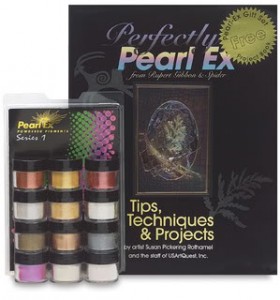
Pearl Ex metallic pigments
Non required for the first couple of projects merely trust me, if y'all don't become them yous'll before long wish you had. These are fantastic for armor and for horses you add just a affect to get the nice sheen of a healthy glaze. I have the Series one 12 Color Gear up with Complimentary Volume except for the neon violet color, all of the other colors work perfectly for armor, metal items, and natural equus caballus colors. But honestly, if I had the money to get all 32 colors, I would! With these comes 1 caveat….

Colour shapers
if you get the Pearl Ex metallic pigments you lot actually demand to get the colour shapers. While I want to demonstrate and explain the products I utilise, I don't desire to say YOU MUST BUY THIS. Merely these two items go mitt in hand and my experience with the generic brands has been poor, so these are the ones I strongly encourage you to become.
I tried applying with a castor and POOF glittery dust explosion everywhere! I tried mixing them with the pigment powder but it was either ineffective or I withal had glittery dust everywhere.When I first started using the Pearl Ex, I did not have these and I absolutely hated the pigment. I tried applying with a brush and POOF glittery dust explosion everywhere! I tried mixing them with the paint powder but it was either ineffective or I still had glittery dust everywhere. These things were so hard to control and to apply where I wanted that I just nearly threw them in the trash. I'm glad I didn't.
Out of sheer luck I plant the Colour Shapers on Dick Blick and decided to try them. They worked nicely, they are a not-porous rubber so you lot can apply them for paint or glue and just wipe them off afterward. Stuff doesn't stick to them. In desperation, I tried them to apply the Pearl Ex. Information technology worked like a charm! Now I accept almost consummate control of awarding and can apply them onto even the smallest piece of armor. Or I tin use metallic paint to a large muscle on the horse to get that realistic sheen and not worry about it flying into areas where I don't need it.
Colour Shapers but came out with a Mini Fix that is perfect for our jobs. I purchased the Firm prepare and then went back and purchased the extra firm set (Clay Shapers). I use them both depending on the task at hand. Whichever one you get depends on your style merely you will really love these when it comes time to apply the metallics. Trust me on this i! You're gonna desire the Mini set Size 0.

Primer
Another must have. Y'all will demand white at the very least. I prep my horses then utilize gray primer considering the contrast on the larger calibration helps me see anything I missed. (When working on miniatures, I just employ white because I don't desire the added layers.) Then I embrace the model in white primer.
My favorite brand is Tamiya Fine Surface Primer, both white and gray but at the time of this writing, Tamiya aerosol cans of any sort are not immune in the U.S. Due to labeling issues. My second option (and it's not far backside Tamiya in quality), Is Vallejo White and Vallejo Gray droplets primers, in fact, I may stick with information technology even if Tamiya comes back. I tested it first and while it'south a bit too easy to over apply and get it to run, it applies nicely and does not cover fine detail.
Basically you want a high quality white primer that has enough "tooth" for the pigments to stick to merely not also much or at that place volition be difficulties with grain downwardly the road. No matter what brand, you MUST prime white as the last footstep. In gild to properly apply pigments and pastels, you must have a white base of operations glaze to get-go.

Matte sealer
I employ Testors Wearisome Cote because it is very matte and is non-yellowing. Plus, it provides the right amount of tooth. If your preference is more towards glossy figures, you can utilise gloss sealer merely be enlightened gloss has less tooth and information technology will be more than hard to apply the pigment.

The sealer I utilise is Testors Dull Cote. It's an acrylic lacquer I believe. Many effigy and mini painters use information technology, especially if they game with their minis. I know folks who don't game are moving abroad from sealer because there is as well great of a chance of that sealer doing foreign things and ruining their hard piece of work. This is why I always spray a examination model start, no thing how many times I've used that can of sealer.
Sure sealers can react with the primer even if you have several layers in betwixt.I use the same sealer for all of it, pigment, paint, pastels. The type of sealer yous use is entirely up to you and if you lot have a brand preference. But likewise exist aware that certain sealers can react with the primer even if you have several layers in between. That happened to a friend of mine. She started using Tamiya primer, painted a horse using the exact same technique I merely described, but when she applied Krylon clear sealer, it started to chimera and everything down to the primer just flaked off. We ended upwardly contacting Tamiya USA and while they had never heard of this happening before, they said it sounded like the Krylon sealer and their primer were non compatible. Anyhow, she went back to Testors and everything has been but fine ever since.
I even employ the Ho-hum Cote on the metallics. Yes, it dulls them down just a little but I can usually get three layers of spraying Dull Cote on the mini before it dulls the metallics completely.
Nylon brushes
For applying pigments and pastels yous do NOT desire to utilize your good paint brushes. Now is the fourth dimension for the inexpensive nylon that can stand up to anything you throw at them. Applying this stuff is hard on brushes and you need the kind that is not too soft or you will striking the brush ferrule against the mini. So become the white nylon brushes that are on sale at Walmart or Michaels for adjacent to nothing. The assorted shapes such as the filbert, flat shader and angled shader also come in handy.

Bead jars
The stackable type come in very handy for mixing pigments and using with pastel sticks. If yous have a jar and a pastel stick, hold the stick over the jar and drag the stick against the edge moving within out, it will grind the stick into powder and the powder just falls correct into the jar….for the well-nigh part.
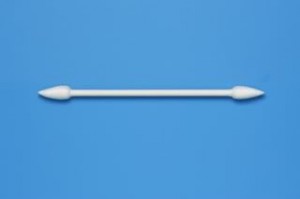
Other supplies
Diverse grits (180 to as high equally you tin find them) sanding sponges. Do not use sandpaper! Pointed cotton swabs from the brand upwards aisle at Walmart or Walgreens, etc. the cheapies are just as of import equally the expensive ones, Tamiya pointed cotton swabs, Canned Air – the same stuff you use for electronics. Colored Pencils – such equally Derwent (not water color), Blackness Charcoal Pencil, White Charcoal Pencil, Brush on Gloss, Gesso (or white castor-on primer), and a Carbide Scraper are all very handy. Don't put your acrylics and brushes away just yet! Y'all'll all the same demand those.
Painting: How to apply dry pigments and pastels
I accept a Work In Progress thread going on CMON and I used a knight's cloak as an example of how to utilise dry pigments. So I'm going to depict on those photos for the purposes of this article. The graphic symbol in question is Pegaso's Roaming Knight and I had started painting the cloak with acrylics, then decided to apply pigments instead and used the example of why nosotros must start with a white base when using pigments and pastels.
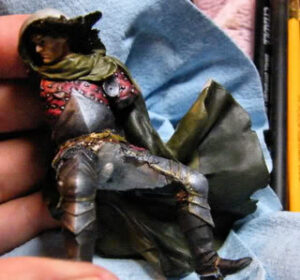
So, our knight is starting of with a standard acrylic layer of paint, a sort of olive drab – think of the old army blankets. It's nothing special, I had wet-blended the acrylic and finished the showtime layer. Then I decided to switch to pigments.
It is important to empathize that pastels and pigments are tints. They are translucent and the first color will show through the 2d colour. The two combine to give you a shade. Start with white primer (or white pigment) every bit a base of operations. It is too important to piece of work from calorie-free to dark. So the next footstep was deciding on the color of pigments I wanted to use.
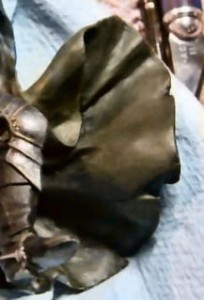
Note: Considering of my hand tremors and the style I need to piece of work, I'm only going to be working on one side of the cloak at a time since I have to lay the model down to work on it. As you tin can run into, I layer towels and practice all I can to protect the piece of work I've already washed.
Calorie-free Sienna
I haven't used this color at all because it has a stiff green undertone and is quite inappropriate for horses. So here it sits, waiting. Now was a perfect opportunity to attempt it out. I purchased these several years ago, earlier World Pigments had accurate photos up, so the stiff green undertone didn't come through until it arrived and I opened the jar.
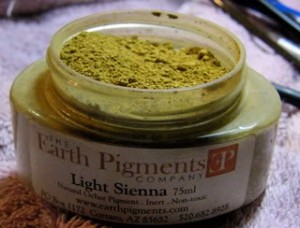
Natural Umber
This is some other strong green undertone color that I haven't had the chance to use.
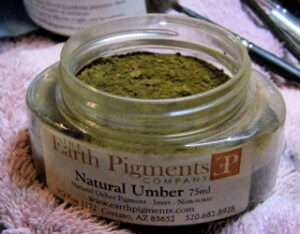
Natural Black
A friend sent this to me to endeavour. This is a relatively new color in the Earth Pigment line. There is another black, an Oxide pigment, Black 318 that is very strong and very intense. It is and then strong, information technology can wipe out virtually anything and everything else. Natural Black is softer, and the blue undertone is supposed to exist less.

So these are the colors I decided to start with and I'm prepared to adapt as I get. Applying pigments and the color achieved is not an exact science. No matter how often I work with them, they can still surprise me and do so quite ofttimes.
Why y'all need a white base
In order to demonstrate the need for a white base of operations, I first by applying the Calorie-free Sienna straight to the knight'due south dark-green acrylic painted cloak. I'm not shy nearly it either. I put my castor into the paint and load information technology up. And then I tap off the excess on the side of the jar – otherwise you will take a cloud of dust that won't quit. I firmly press the castor against the cloak but not and so difficult that I push the ferrule into it. I use a slight stippling motion with a drag to apply the pigments. I'm literally staining the cloak as I go.
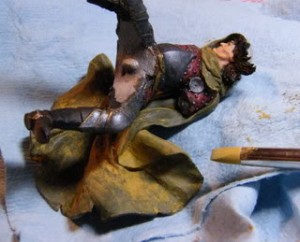
In order to get really solid coverage of pigment. I get my Colour Shaper out and use that to press the pigment onto the cloak. When it's finally covered, I take my canned air and blow off the excess dust. This is an of import step. If the excess powder remains, and sealer is applied, it literally turns to mud. At present if we were truly weathering, we might want this effect but for this, we don't.

Y'all tin can also utilise lung ability to blow of the dust only I guarantee if you do, sooner or later yous're going to spit on your work. Trust me, information technology's happened to me more than times than I care to count and information technology will happen to you lot eventually. When that happens, fix the model bated to dry. If you don't mess with it, it should disappear on its own.Yous tin too apply lung ability to blow of the dust merely I guarantee if you exercise, sooner or later you're going to spit on your piece of work.
Once the excess dust is blown off it is time to seal. Have the Dull Cote and be certain to shake well! In fact, it's a good thought to accept a test model handy because cans have been known to freak out and do crazy things in the centre of spraying. Then hitting a test model start is amend than ruining your hard work.
Yous desire to lightly embrace the area with pigment. Do not soak it, practice not permit it puddle. In fact, two-4 very light coats of sealer is the way to get. It also depends on the size of the model, a large one will need more than a minor 1. The really minor ones you need to be very careful of how many layers and how thick you apply so you don't obscure fine detail.
Now our sealer is practical and what do nosotros have to show for information technology?
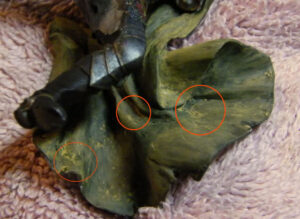
A large mess! The pigments actually disappeared against the dark base coat. The merely thing that remains are the yucky spots where I applied too much pigment and too much sealer. I've circled the problem areas in the photo and did this to make a couple of important points. If you lot do not employ a white base, your pigments volition about likely disappear. You will also probably endeavour to apply them too thick and end up with mud as in the photograph.

The higher up photo looks absolutely awful.
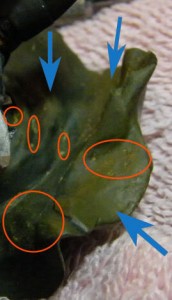
But I too want to signal something out. Even though our paint disappeared agains the dark base, if yous look closely where I have the blue arrows, y'all can see where some of information technology did highlight an area or ii. The effect is very subtle and difficult to see, but information technology is at that place.
So at present what do we do? Is our knight hopeless considering I applied paint to a dark basecoat? Practice I have to strip him?
No – he is yet very manageable. With a piddling endeavor he will be right as rain.
The start thing I do is use a loftier grit sanding sponge – a sponge, not sandpaper to lightly sand off the pigment mud and goobers left behind. Sandpaper will crease and gouge the layers, many times damaging your basecoat.

I don't even have to strip the cloak, just become the nasties off. In one case I exercise that, I take Gesso and thin it really well. Gesso is infamous for leaving castor strokes and then you want information technology adept and thin. If yous don't take Gesso, in this detail case – recovering from a mistake – brush on primer volition work just besides. I recently purchased Vallejo's White Brush-On Primer and I dearest that stuff! Gesso is out the door unless I'm out of the Vallejo.
I use two layers of Gesso to the cloak. Now we have our white basecoat and can movement forward.
Layer i
Remember always apply colors calorie-free to dark. Yous demand to piece of work in layers. Trying to rush to a darker colour volition only lead to problems. Yous are basically working with colored clay here. Ochers and Oxide pigments are like petty grains of sand. They don't dissolve. You press them into your base of operations until there is no more surface surface area for the grains to adhere to. One time the layer has reached its "saturation level" the pigment colour will stop growing darker or denser. That means it's time to seal.
<span="inset-right">Once the layer has reached its "saturation level" the paint color will stop growing darker or denserApplying sealer keeps the tiny paint grains in place. It also provides a new, relatively clean surface area for more grit to adhere to and then you tin apply another layer. Only rushing this and going nighttime too fast can crusade grain, an ugly mish-brew of uneven pigment.
Grain shows upward the worst when yous motion to a darker color and you lot will need to either become back a stride and return to applying the lighter color, or endeavour to lightly sand information technology out without messing up your basecoat. Sometimes both! So brand sure you take good coverage and don't get dark too soon, that'southward the best way to avert the hassle with grain.
First, I utilize a layer of Light Sienna.
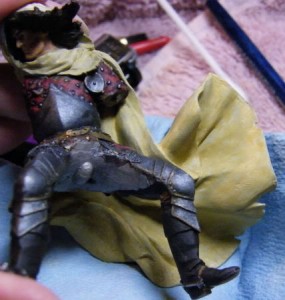
Already information technology looks totally different and much much meliorate! It's a little streaky but that's okay, more often than not the sealer application will darken the colour and tone that down. The cloak now has a soft gilt expect to it. After blowing off the excess, I utilise my sealer.
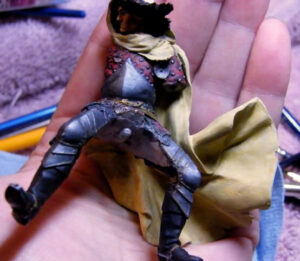
Will you look at that! The picture above looks Aught similar that green disaster we had a brusque fourth dimension agone! Now I expect for the sealer to dry, approximately twenty minutes but this may vary depending on the weather and humidity in your surface area.
Layer two
As mentioned previously, I don't desire grain then I don't go too dark too fast. I apply a second layer of Calorie-free Sienna and seal.

Find how this time we have a lot more green undertone than previous. Every bit I said, pigments and pastels are tints and translucent and then basic color theory will start to utilize.
How do you know when to apply 1 coat, 2 coat, or more of a certain color? For the almost part, that is only going to come with feel and seeing how the colors lay down in various situations.
In this case, I don't want whatever more light-green at this light colour. Because of my planned colors, I know I'm going to get more than green equally I get but right now, want to go darker before we go greener. Make sense?
Layer three
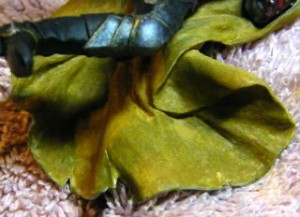
Now, I apply the Natural Umber. WOW! Major green going on here! Lol! This is not just going night, information technology'southward going REALLY green. And then I decide ane layer is enough. I don't want the cloak to be the same color of green as the scented Pine deoderizer hanging from the review mirror in somebody's car.
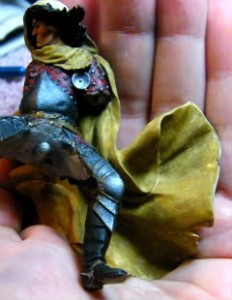
Layer 4
So allow's spring direct to the black. At present in this case, we desire to use the black for shadows only. If we encompass the entire cloak, it volition become way besides dark. I start by applying the Natural Black – or at to the lowest degree trying to. Unfortunately, fifty-fifty with the Colour Shaper applicators, the colour has no strength to it at all. It's going to take me forever at this rate. So I pull out my Black 318. Retrieve I said this stuff was strong? Check this out:
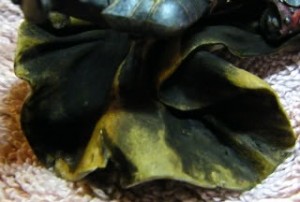
Yeah, this was supposed to be a minimal application. I don't think "minimal" is in the dictionary when information technology comes to this black oxide.
So I seal layer four and look what I have every bit a event. The cloak simply swerved a difficult right from green to brown. See, I told you these things can still surprise me.

Now here is the fun part. This is where I go to prove you how to exercise what I said (and demonstrated) before what Not to do! 😆
Layer five
I am going to apply a lighter color on top of a dark colour, specifically a light brown. The cloak is now going too dark. At that place's just too much "muck". Over again, this isn't an exact science so you lot are going to go color twists and curves that you take to acquire how to handle. Again, experience is the all-time teacher to know if you can work through information technology or if you have to strip it and first over. Always do yous best to work through it, over information technology, sideways…something! Leave stripping as a concluding resort.
Experience also teaches you lot how diverse colors and types of pigments (this includes pastels too) will react. I mentioned the Black 318 is one of the strongest oxide pigments I have. Well, I have another oxide pigment that is strong, has great coverage and tin nearly handle anything thrown at it. It comes in a potent second to the Blackness 318. It is Titanium White.
The simply problem, Titanium White has a very, very strong blue undertone. I've had it turn my stuff purple more times than I care to count! So I've learned to offset this with bones colour theory and adding a color to the mix to help neutralize that blue undertone. In this example it is Light Yellow Ochre. The mix turns into a buff colour and I apply a layer.
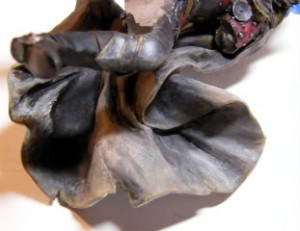
Every bit before with the green, you see I have a very stark contrast between the light color and my original dark-green/blackness. But I oasis't sealed still and that is the key.
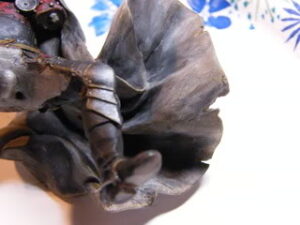
Upon application of the sealer, the light colour does as before it nearly disappears completely. Only if you look closely you can see where the calorie-free tan stuck and while it is still subtle, it stuck with a lot more than strength than our first endeavour.

Information technology's all about learning what specific types of oxides and ochers, also as colors, can do.
Layer half dozen, vii, and eight
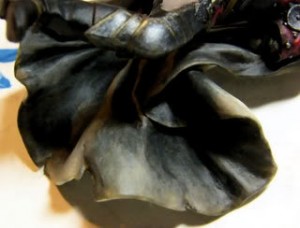
I stay with this buff color for these adjacent three layers. I demand to mention these are specifically applied with the Colour Shapers and each layer sealed. What a difference in that photo in a higher place, huh? 🙂 And although I'm keeping my layers and sealer thin, we notwithstanding don't desire to apply besides many. And then here is where I call the inside of the cloak done. Bank check out this last photograph!
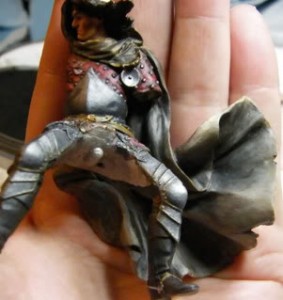
The back of the cloak – leather effect
Above we accomplished a dainty low-cal color with night shadows. To me, the inside of the cloak looks like Oil Skin. But I would like to show you some quick and piece of cake steps to create a true leather outcome. Our kickoff layer of color is as before Light Sienna and seal. For the second layer, this time I get ahead and go slightly darker – not much, just a little and utilize a soft red colour with a hint of orangish called Rose Globe and I seal that besides.

Third and fourth layers

This is another new color called Cypress Umber Warm. Umbers have a tendency to posses a strong cool cast, basically dejection and greens. This one has a warmer bandage to it and I wanted to see how information technology would piece of work. After sealing I immediately moved to the Black 318 just using my Colour Shapers I was very cautious to just apply it to the deepest recesses.
And wow – instant leather! And this is only four layers folks!

Fifth layer
And so what exercise I do afterward the sealer dries? I become and pause my own rules again. At this rate, you're not going to take me seriously! Lol! The Colour Shaders have a tip called a Cup Chisel. I used this and returned to my 2nd layer colour, Rose Globe. This time I applied information technology Simply to the highest points on the folds of the cloak. The Cup Chisel works perfectly for this shape. And one time once more I sealed.
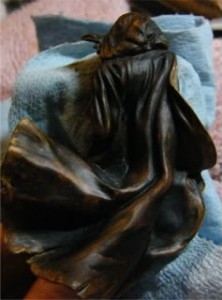
Sixth layer
Again repeating the Rose Globe highlights with the Cup Chisel and sealing.

7th layer
The insanity strikes again. Instead of going lighter on the loftier points of the cloak, this time I went redder. I used Colonial Ruby-red pigment and it is red without having a lot of orangish just it'southward non Bright RED either.
I got interesting results and then after I sealed I took a series of pictures. The but editing I did was to crop, resize and put them into a console. The changes you see are only angle of camera and lightly. They are very modest adjustments just you lot can see the effect this achieved.


Each panel appears to exist different stages of pigment application simply they are not. This is ane awarding and the only thing changing is the position of the effigy and the bending I'm holding the camera.
My friends, in my apprehensive stance, that is leather.
All of this created with dry pigments and "painting".
A few words about metallics
At present this helm I did entirely with metallics and sealed with Dull Cote. I have different colors of silver metallics, just similar we take different colors of silver paint. I used them for highlights and shadows but equally if they were paint.



I do need to mention metallic pigments are an entirely unlike critter from regular pigments. They are NOT translucent and yous need to use a blackness base coat with them, unlike the white of the regular pigments. Blackness allows them to pop. If y'all employ white or a light colored base, they become kinda soft pastel colors rather than having the zing they normally do.
And here is a photo of the miniature nosotros were painting. (Nonetheless very much a WIP)
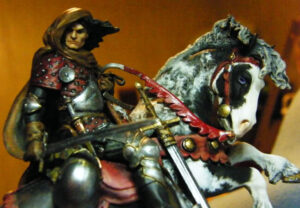
I promise you've enjoyed this article and found it informative. Delight comment if you have whatsoever questions! I am happy to help however I can.
— Kathryn
How To Use Pigment Powder,
Source: https://chestofcolors.com/how-to-paint-with-dry-pigments/
Posted by: jacksonsheyesseet.blogspot.com


0 Response to "How To Use Pigment Powder"
Post a Comment